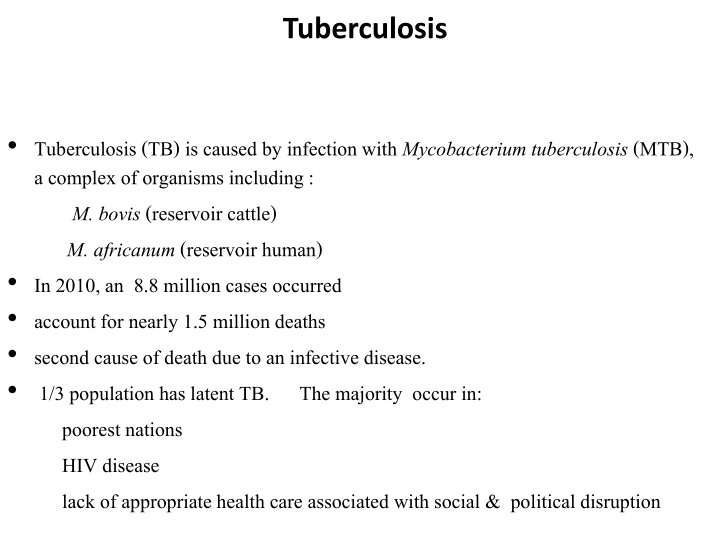
Tuberculosis: Causes, Risk Factors, and Clinical Features
Tuberculosis (TB) is a serious infectious disease caused by Mycobacterium tuberculosis. This article discusses the pathology, risk factors, and natural history of TB, along with clinical features such as pulmonary disease and miliary TB. Learn about the impact of TB on global health and the importance of early detection and treatment in combating this disease.
Download Presentation

Please find below an Image/Link to download the presentation.
The content on the website is provided AS IS for your information and personal use only. It may not be sold, licensed, or shared on other websites without obtaining consent from the author. If you encounter any issues during the download, it is possible that the publisher has removed the file from their server.
You are allowed to download the files provided on this website for personal or commercial use, subject to the condition that they are used lawfully. All files are the property of their respective owners.
The content on the website is provided AS IS for your information and personal use only. It may not be sold, licensed, or shared on other websites without obtaining consent from the author.
E N D
Presentation Transcript
Tuberculosis Tuberculosis (TB) is caused by infection with Mycobacterium tuberculosis (MTB), a complex oforganisms including : M. bovis(reservoir cattle) M. africanum(reservoir human) In 2010, an 8.8 million cases occurred account for nearly 1.5 million deaths second cause of death due to an infective disease. 1/3 population has latent TB. The majority occur in: poorest nations HIV disease lack of appropriate health care associated with social & political disruption
Pathology & pathogenesis inhalation of bacilli Alveolar lodgment with ,lymphocyte ,macrophage Epitheloid, macrophage, lngerhan cells ( granuloma) Numerous granuloma(ghonfocus) Lymph node (primary complex) Latent TB Calcifications Lymphatic, hematological seeding
Factors increasing the risk of TB Factors increasing the risk of TB Associated diseases Immunosuppression: HIV high-dose corticosteroids Malignancy Diabetes mellitus Chronic kidney disease Silicosis Gastrointestinal (malnutrition's) Deficiency of vitamin D or A Recent measles in children Patient-related Age (children > young adults < elderly) First-generation immigrants from high- prevalence countries Close contacts with smear-positive pulmonary TB Overcrowding (prisons ) Chest X-ray evidence of self-healed TB Primary infection < 1 yr previously Smoking
Natural history of untreated primary TB Arnold; 1998. Time from infection Manifestations 1. Primary complex, positive tuberculin skin test 2. Meningeal, miliary ,pleural disease 3. Gastrointestinal, bone ,joint, and lymph node disease 4. Renal tract disease 5. Post-primary disease due to reactivation or re-infection 1. 3 8wks 2. 3 6 mths 3. Up to 3 yrs 4. Around 8 yrs 5. From 3 yrs onwards
Clinical features: pulmonary disease Primary pulmonary TB infection of a previously uninfected (tuberculin-negative). self-limiting febrile illness clinical disease ( hypersensitivity reaction or progressive infection). Progressive primary disease may appear during the course of the initial illness or after a latent period of weeks or months.
2.Miliary TB Blood-borne dissemination , may present : acutely but more frequently 2 3 weeks of fever, night sweats, anorexia, weight loss and a dry cough, Hepato-splenomegalymay develop and the presence of a headache Auscultation: frequently normal, in advanced disease, widespread crackles Fundoscopymay show choroidaltubercles. chest X-ray are of fine 1 2 mm lesions ( millet seed ) Anaemia and leucopenia reflect bone marrow involvement. Cryptic miliary TB is an unusual presentation sometimes seen in old age.
Post-primary pulmonary TB exogenous ( new infection) endogenous (reactivation of a dormant primary lesion) frequently pulmonary in the apex of an upper lobe.(oxygen tension) The onset is usually insidious Systemic symptoms include fever, night sweats, malaise, and loss of appetite and weight progressive pulmonary symptoms Very occasionally, complications Radiological changes : ill defined opacificationin one or both of the upper lobes consolidation, collapse and cavitation the presence of a miliarypattern or cavitationfavoursactive disease. displacement of the trachea and mediastinum. tuberculouspneumonia.
Disease Lymphadenopathy: hilar (often unilateral), paratracheal or mediastinal Collapse (especially right middle lobe) Consolidation (especially right middle lobe) Obstructive emphysema Cavitation (rare) Pleural effusion Miliary Meningitis Pericarditis Features of primary TB Infection (4 8 wks) Influenza-like illness Primary complex Skin test conversion Hypersensitivity Erythema nodosum Phlyctenular conjunctivitis Dactylitis
Clinical presentations of pulmonary TB Clinical presentations of pulmonary TB Chronic cough, often with haemoptysis Pyrexia of unknown origin Unresolved pneumonia Exudativepleural effusion Weight loss, general debility Spontaneous pneumothorax Asymptomatic (diagnosis on chest X-ray)
Cryptic TB occur in Age over 60 yrs Intermittent low-grade pyrexia of unknown origin Unexplained weight loss, general debility (hepatosplenomegalyin 25 50%) Normal chest X-ray Blood dyscrasias; leukaemoidreaction, pancytopenia Negative tuberculin skin test Confirmation by biopsy with granulomasand/or acid-fast bacilli in liver or bone marrow
Chronic complications of pulmonary TB Pulmonary Massive haemoptysis Cor pulmonale Fibrosis/emphysema Atypical mycobacterial infection Aspergilloma Lung/pleural calcification Obstructive airways disease Bronchiectasis Bronchopleural fistula Non-pulmonary Empyema necessitans Laryngitis Enteritis* Anorectal disease* Amyloidosis Poncet s polyarthritis
